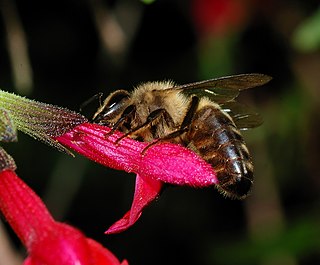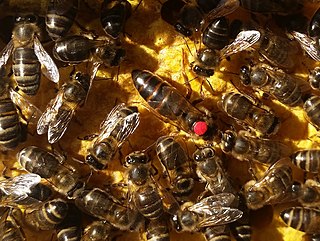
A honey bee is a eusocial flying insect within the genus Apis of the bee clade, all native to mainland Afro-Eurasia. After bees spread naturally throughout Africa and Eurasia, humans became responsible for the current cosmopolitan distribution of honey bees, introducing multiple subspecies into South America, North America, and Australia.

The Africanized bee, also known as the Africanized honey bee and colloquially as the "killer bee", is a hybrid of the western honey bee, produced originally by crossbreeding of the East African lowland honey bee (A. m. scutellata) with various European honey bee subspecies such as the Italian honey bee (A. m. ligustica) and the Iberian honey bee (A. m. iberiensis).
Within biological taxonomy, a honey bee race would be an informal rank in the taxonomic hierarchy, below the level of subspecies. It has been used as a higher rank than strain, with several strains making up one race. Therefore, a strain is a lower-level taxonomic rank used at the intraspecific level within a race of a subspecies. Strains are often seen as inherently artificial concepts, more usually within biology as characterized by a specific intent for genetic isolation, however, within beekeeping circles, strain is more likely to be used to describe very minor differences throughout the same subspecies, such as the color ranges of A. m. carnica from brown to grey. Within A. m. ligustica there are two races, the darker leather brown northern Italian bee from the Ligurian Alps region which was discovered to be resistant to acarine in the 1900s, while the other Italian bee race, from regions near Bologna and further south, was highly susceptible to acarine and within this race there are two color strains, the traditional Italian yellow and a rarer all-golden color.

The European dark bee is a subspecies of the western honey bee, evolving in central Asia, with a proposed origin of the Tien Shan Mountains and later migrating into eastern and then northern Europe after the last ice age from 9,000BC onwards. Its original range included the southern Urals in Russia and stretched through northern Europe and down to the Pyrenees. They are one of the two members of the 'M' lineage of Apis mellifera, the other being in western China. Traditionally they were called the Black German Bee, although they are now considered endangered in Germany. However today they are more likely to be called after the geographic / political region in which they live such as the British Black Bee, the Native Irish Honey Bee, the Cornish Black Bee and the Nordic Brown Bee, even though they are all the same subspecies, with the word "native" often inserted by local beekeepers, even in places where the bee is an introduced foreign species. It was domesticated in Europe and hives were brought to North America in the colonial era in 1622 where they were referred to as the English Fly by the Native Americans.

The Carniolan honey bee is a subspecies of the western honey bee. The Carniolan honey bee is native to Slovenia, southern Austria, and parts of Albania, Croatia, Bosnia and Herzegovina, Montenegro, Serbia, Hungary, Romania, Bulgaria and North-East Italy.

The Cape honey bee or Cape bee is a southern South African subspecies of the western honey bee. They play a major role in South African agriculture and the economy of the Western Cape by pollinating crops and producing honey in the Western Cape region of South Africa. The species is endemic to the Western Cape region of South Africa on the coastal side of the Cape Fold mountain range.
Lamarck's honey bee or the Egyptian honey bee, Apis mellifera lamarckii, is a subspecies of honey bee occurring in a narrow range along the Egyptian Nile Valley of Egypt and Sudan, named after Jean-Baptiste Lamarck and is considered the first honey bee domesticated, before 2600BC.
The Maltese honey bee, Apis mellifera ruttneri, is a subspecies of the western honey bee, endemic to the Maltese islands which are situated in the Mediterranean Sea.

The East African lowland honey bee is a subspecies of the western honey bee. It is native to central, southern and eastern Africa, though at the southern extreme it is replaced by the Cape honey bee. This subspecies has been determined to constitute one part of the ancestry of the Africanized bees spreading through North and South America.

The Macedonian bee is a subspecies of the Western honey bee. It is found mainly in Albania, Bulgaria, North Macedonia, Northern Greece and other places in the Balkans as well. Originally this subspecies was described based on morphological characteristics by Friedrich Ruttner, as were the adami, cecropia and cypria subspecies.

The western honey bee or European honey bee is the most common of the 7–12 species of honey bees worldwide. The genus name Apis is Latin for "bee", and mellifera is the Latin for "honey-bearing" or "honey carrying", referring to the species' production of honey.
Apis mellifera iberiensis, or the Spanish bee, is a western honey bee subspecies native to the Iberian Peninsula. It is also found on the Balearic Islands.

Apis cerana, the eastern honey bee, Asiatic honey bee or Asian honey bee, is a species of honey bee native to South, Southeast and East Asia. This species is the sister species of Apis koschevnikovi and both are in the same subgenus as the western (European) honey bee, Apis mellifera. A. cerana is known to live sympatrically along with Apis koschevnikovi within the same geographic location. Apis cerana colonies are known for building nests consisting of multiple combs in cavities containing a small entrance, presumably for defense against invasion by individuals of another nest. The diet of this honey bee species consists mostly of pollen and nectar, or honey. Moreover, Apis cerana is known for its highly social behavior, reflective of its classification as a type of honey bee.
Beekeeping is first recorded in Ireland in the seventh century. It has seen a surge in popularity in modern times, with the membership of beekeeping associations exceeding 4,500. The median average number of hives per beekeeper is three hives, while the average honey output per hive is 11.4 kg. The growth in the practice has occurred despite increased pressures on bees and beekeepers due to parasites, diseases and habitat loss.

Apis mellifera intermissa is an African subspecies of the western honey bee.
Apis mellifera artemisia is the Russian steppe honey bee, first identified in 1999 near Kyiv, Ukraine, by only one specimen, but by 2011 its taxonomic status had been called into question, although to date no DNA analysis has been conducted: At the same time the taxonomic status of the Apis mellifera ruttneri on Malta was also called into question, however in 2017 it was confirmed that Apis mellifera ruttneri was a new and separate subspecies.
Apis mellifera sossimai extending from the west of Ukraine centrally and southwards towards the Caucasus mountains. However in 2011 research from Russia conducted mtDNA analysis showing that the A. m. sossimai was not a separate subspecies, but only an ecotype of the Apis mellifera macedonica subspecies.
Apis mellifera taurica along the north central shores of the Black Sea, in the Crimea. However in 2011 research from Russia questioned the taxonomic status of A. m. taurica citing mtDNA analysis to the north and west of Crimea, which had shown that those regions did not have distinct subspecies, but that their honey bees were at the most ecotypes of previously known subspecies.
Apis mellifera simensis is known by the common name of the Ethiopian honey bee, discovered in 2011 through DNA analysis, which directly contradicted previous researchers which had misidentified the honey bees of Ethiopia, attributing them to neighboring subspecies in eastern Africa, in part due to similar Morphometrics. A. m. simensis was found to deviate substantially from other Apis mellifera when genetically analysed, in that a new Y Lineage branch of the Apis mellifera was created for them: There had previously thought to be up to five different subspecies within Ethiopia.









